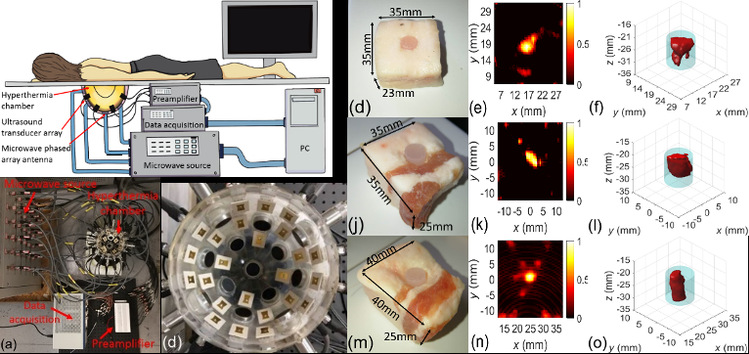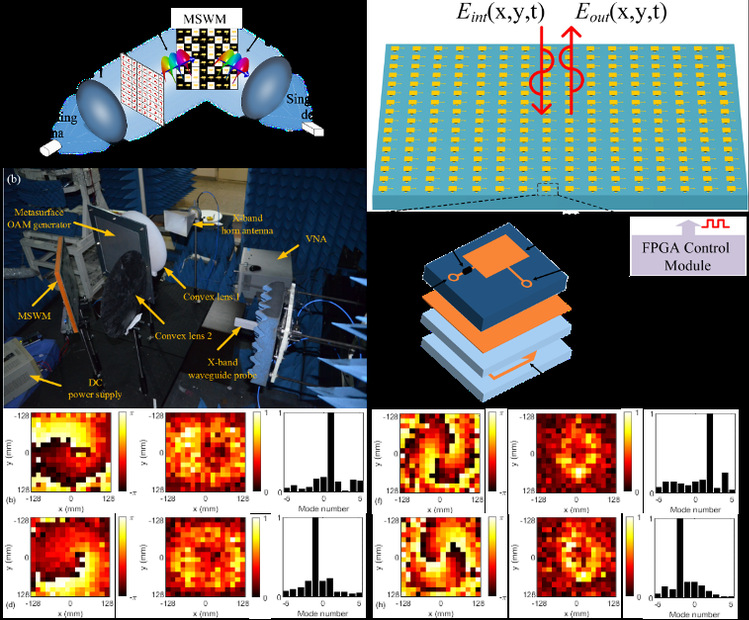Assistant Professor Wang Xiong’s research group from Smart Medical Information Research Center at SIST is focusing on electromagnetic acoustic hybrid imaging, focused microwave and ultrasound hyperthermia for cancer, and research on electromagnetic wave and acoustic wave metasurfaces. Recently, the group has made a series of advances in the field of electromagnetic acoustic imaging.
1. Preclinical prototype of focused microwave hyperthermia based on compressive thermoacoustic tomography
New non-invasive focused microwave hyperthermia technology for breast cancer has received extensive attention and research in recent years. Lately, Professor Wang Xiong’s group has developed a preclinical prototype system of focused microwave breast cancer hyperthermia based on compressive thermoacoustic tomography monitoring technology. They used a variety of breast phantoms to perform a large number of experimental verifications and got satisfactory results, making this novel technique a new potential solution and paradigm for accurate and non-invasive breast cancer treatment. Their achievement was recently published in a top journal - IEEE Transactions on Biomedical Engineering - in an article entitled “A Preclinical System Prototype for Focused Microwave Breast Hyperthermia Guided by Compressive Thermoacoustic Tomography”.
The prototype system includes a customized microwave patch antenna array, ultrasonic transducer array, and experimental data acquisition and analysis equipment. Several phantoms and biological samples, with a 1-cm-size tumor phantom inside each sample, were used to test the validity of this system. The experimental results prove that the compressive thermoacoustic tomography is able to monitor the microwave power distribution in the sample and guide the entire microwave focusing process to achieve the purpose of real-time monitoring.
This work lays the foundation for the clinical application of low-cost, non-invasive, accurate and safe breast tumor treatment. It may also contribute to other disease treatments as contrast-enhanced hyperthermia, heat-activated drug delivery and postoperative adjuvant therapy.

Fig.1. Schematic diagram of the clinical system, overall experimental system, samples and experimental results
Master student of Class of 2021, Li Jianian, is the first author of this article, Prof. Wang Xiong is the corresponding author. ShanghaiTech is the only completion unit.
Article link: https://ieeexplore.ieee.org/document/9366382/
2. Single-sensor compressive imaging technology for orbital angular momentum detection based on a microwave spatial wave modulator
The orbital angular momentum (OAM) feature is a vector feature of electromagnetic waves with broad prospects for development. It can be used not only to improve spectrum utilization and increase transmission rate in wireless communication, but also has great research value in the field of security and confidential communication with its good directionality. The traditional near-field mechanical scanning technology used to measure the intensity and phase distributions of OAM beams is very time-consuming due to the small spatial step setting required in order to guarantee accuracy. Meanwhile, the high-precision scanning platform also increases the cost and volume of the measurement system. Prof. Wang Xiong’s group developed a new technique to characterize a microwave OAM beam by applying a single-sensor compressive imaging (SSCI) strategy, which is much more time-efficient, cost-effective and compact than the traditional methods. This result was published in an article entitled “Characterization of Orbital Angular Momentum Applying Single-Sensor Compressive Imaging Based on a Microwave Spatial Wave Modulator”, in a top journal - IEEE Transactions on Antennas and Propagation.
In this study, the group built an experimental system and successfully verified the feasibility of the experiment system via 1st and 2nd order OAM beams. A microwave spatial wave modulator (MSWM) implemented by a programmable metasurface using microwave frequency bands generates a set of random mask patterns and modulates the OAM beam to be measured. The information from the modulated beam is collected by a single sensor and reconstructed through a compressive sensing algorithm. The obtained reconstruction results show the high-quality phase and amplitude distribution of the OAM beams under test. This work confirmed the effectiveness of the proposed SSCI technology and laid a theoretical and experimental foundation for the rapid and economical measurement of microwave and millimeter wave OAM beams.

Fig. 2. Setup of the SSCI technique experimental system and Reconstructed imaging results
This work was completed by Shanghaitech University and Tsinghua University. The first author of this work is the Master student of Class of 2020 at ShanghaiTech, Lin Zhansong, Prof. Wang Xiong and Prof. Yang Fan from Tsinghua University are the co-corresponding authors.
Article link: https://ieeexplore.ieee.org/document/9397381/




 沪公网安备 31011502006855号
沪公网安备 31011502006855号


